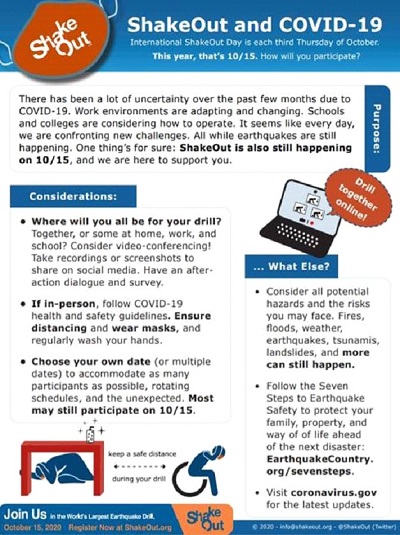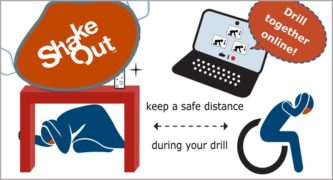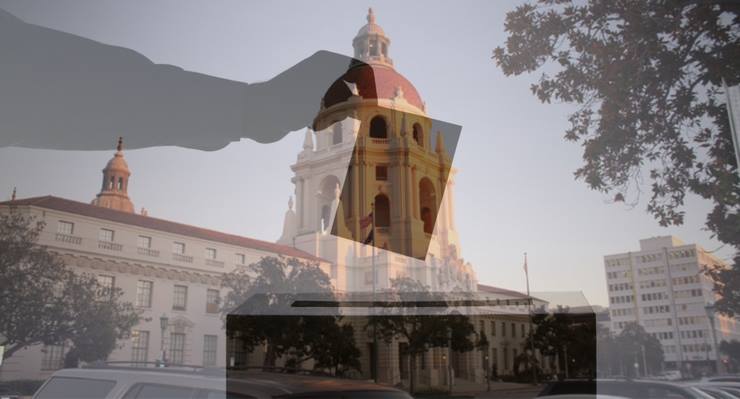
The threat of approaching flames to the foothill communities of Pasadena from the Bobcat Fire in the Angeles National Forest has subsided, and the county has seen significant strides in the fight against the COVID-19 pandemic in recent weeks.
Now, officials are urging the public to remain mindful of another looming threat to Southern California: Earthquakes.
The third Thursday of October each year marks California’s statewide earthquake drill known as the Great Shakeout. This year, it will fall on Oct. 15.
For many in Pasadena, the point was driven home earlier this month when a 4.5-magnitude earthquake epicentered deep underground along the Whittier Fault near South El Monte shook the region on Sept. 18, but resulted in no reported damage or injuries.
Margaret Vinci was ready to go when she felt the shaking. As she often advises others, she had equipment including a flashlight, sturdy shoes and a hardhat at the ready beneath her bed.
The likelihood of broken glass strewn around in the wake of an earthquake is high, so “Put on those items first before you jump out of bed,” she said.
Following the Northridge Earthquake of 1994, “The number one injury was cut feet. Second: cut hands,” Vinci said.
Vinci lives and breathes earthquakes. She serves as manager of the Office of Earthquake Programs at Caltech and is a regional ShakerAlert coordinator, a volunteer with the Pasadena Fire Department’s Community Emergency Response Team, or CERT, and a coordinator of Pasadena’ “Map Your Neighborhood” emergency response program. She was part of the original committee that formed the Great ShakeOut in 2008.
While people may react differently to various forms of disaster, such as evacuating from a fire or sheltering in place following an earthquake, “With any disaster, preparedness is the same,” Vinci said. “The more prepared you are, the better your survivability,”
In addition to shoes and a flashlight near the bed, Vinici said people should also have additional supply kits at the ready. A “go bag” should contain all the needed supplies for three days. And multiple bags should be made, so they can be kept in the home, in the car and in the workplace, in case a disaster occurs while away from home. A larger disaster kit should contain “Anything needed to camp for three to four weeks,” Vinci said.
“Water is key. One gallon per person per day, for seven to 10 days, if not longer,” according to Vinci.
The kit should also include “things that you use every day: Hygiene items, deodorant, makeup…”
It’s also wise to include some specialized equipment, such as a whistle to signal for help, or a crowbar to help free people trapped by debris.
Pets will need food, toys, and water as well, she said. Booties are also a good idea to prevent animals from stepping on broken glass.
People should take time to make a plan to react to an earthquake in each room of their homes, paying attention to where hazards are.
Upon feeling an earthquake or receiving an electronic earthquake early warning, people should immediately duck, cover and hold on tight, and not try to wait to see how intense the shaking will get, she said.
“Drop before the shaking throws you off your feet. Get under something, hold onto whatever you’re under so it doesn’t walk away from you,” Vinci said. If there is nothing to hide beneath, she suggests getting near an interior wall.
By the time alerts are sent out, “You only have seconds. The earthquake has started,” Vinci said. The system is designed to issue alerts to areas where a 4.5-magntitude or greater earthquake has been detected and expected shaking intensity reaches a predetermined limit. Those closest to the epicenter receive little or no warning, while those farther out may get an alert several seconds before shaking is felt, Vinci explained.
Those who are in bed when an earthquake strikes should remain there and cover their heads with pillows and blankets, she said.
“Beware of aftershocks. Don’t be near glass, don’t be near chimneys, don’t go outside until it’s safe,” she advised. Even in the wake of an earthquake, “Be cognizant of social distancing.”
Pasadena takes part in the “Map Your Neighborhood” program, which is designed to help neighbors look out for one another in the wake of a disaster.
Participants take part in a 90-minute program, which includes a video presentation and a brochure. The idea is to link neighborhoods of 18 to 22 households so that neighbors can check on each one within an hour of an earthquake or other disaster.
Neighbors are encouraged to get to know each other and learn how many people live in each home, whether children or people with special needs live inside, whether there are animals, and so forth. With that knowledge, people can check on vulnerable neighbors in the wake of a disaster without delay.
Neighbors also create a map of their neighborhood, taking note of where each home’s gas and water shutoffs are located under the program, Vinci said.
Community members are also able to identify what assets exist in their neighborhood. From plumbers to medical professionals, when coping with a tragedy, “everybody has an asset,” Vinci said.
The ongoing pandemic has made communicating the importance of earthquake preparedness extra challenging this year, according to Vinci.
“It is difficult, trying to get these messages out in a world where we have to do social distancing,” she said.
The city’s CERT team has temporarily halted training new members amid the pandemic. Officials were still determining whether they would adopt an online training program, or wait until the pandemic passes to resume training CERT members.
Those unable to take part at 10:15 a.m. on Oct. 15 are urged to practice the drill on a different time or day, at their convenience, Vinci said.
“You can ShakeOut when and where you want, whether that’s at home, work, school, or even through a video conference,” ShakeOut organizers said in a written statement. “We can and should still practice how to be safe when the earth shakes, especially when your situation changes.”
Those taking part are encouraged to register for the California Shakeout online at shakeout.org/california, where additional information is also available.
More information on Pasadena’s Map Your Neighborhood program is available online at cityofpasadena.net/fire/community-programs/map-your-neighborhood.














 1 comment
1 comment


